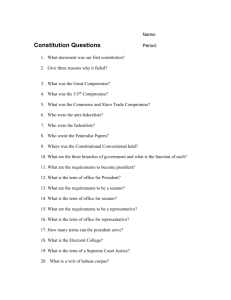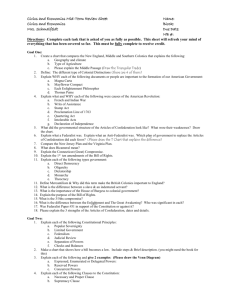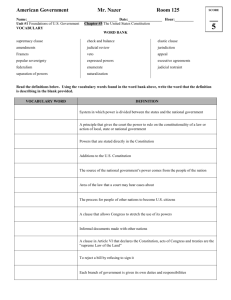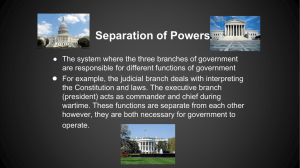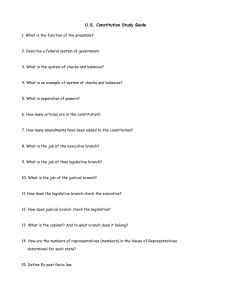File
advertisement
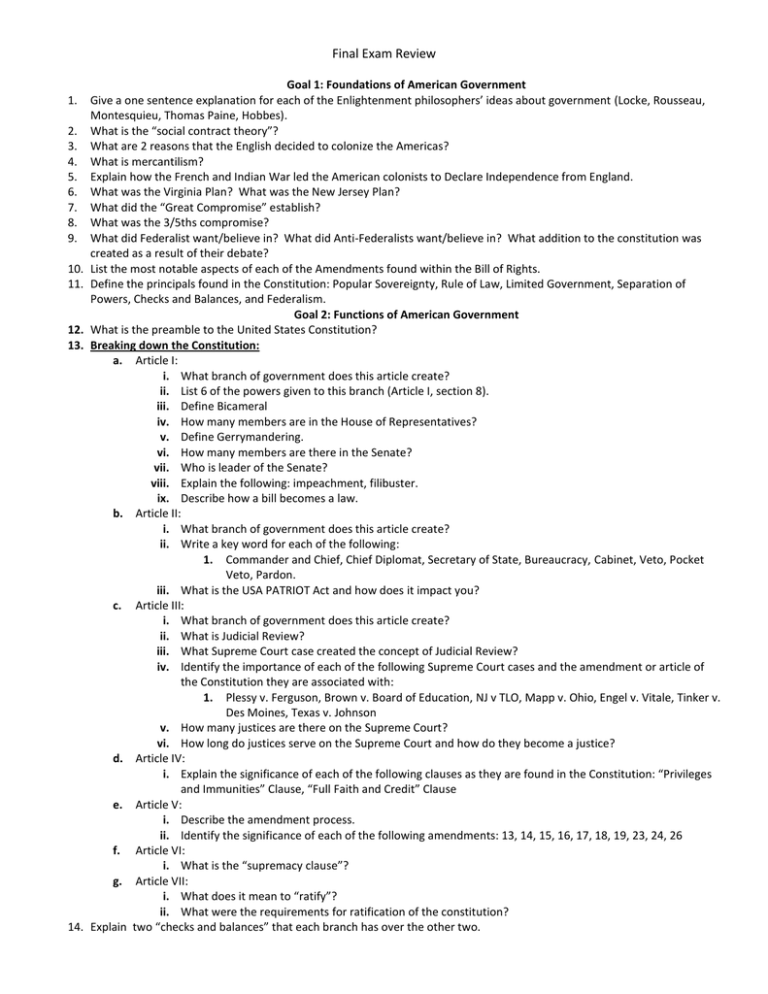
Final Exam Review 1. 2. 3. 4. 5. 6. 7. 8. 9. 10. 11. 12. 13. 14. Goal 1: Foundations of American Government Give a one sentence explanation for each of the Enlightenment philosophers’ ideas about government (Locke, Rousseau, Montesquieu, Thomas Paine, Hobbes). What is the “social contract theory”? What are 2 reasons that the English decided to colonize the Americas? What is mercantilism? Explain how the French and Indian War led the American colonists to Declare Independence from England. What was the Virginia Plan? What was the New Jersey Plan? What did the “Great Compromise” establish? What was the 3/5ths compromise? What did Federalist want/believe in? What did Anti-Federalists want/believe in? What addition to the constitution was created as a result of their debate? List the most notable aspects of each of the Amendments found within the Bill of Rights. Define the principals found in the Constitution: Popular Sovereignty, Rule of Law, Limited Government, Separation of Powers, Checks and Balances, and Federalism. Goal 2: Functions of American Government What is the preamble to the United States Constitution? Breaking down the Constitution: a. Article I: i. What branch of government does this article create? ii. List 6 of the powers given to this branch (Article I, section 8). iii. Define Bicameral iv. How many members are in the House of Representatives? v. Define Gerrymandering. vi. How many members are there in the Senate? vii. Who is leader of the Senate? viii. Explain the following: impeachment, filibuster. ix. Describe how a bill becomes a law. b. Article II: i. What branch of government does this article create? ii. Write a key word for each of the following: 1. Commander and Chief, Chief Diplomat, Secretary of State, Bureaucracy, Cabinet, Veto, Pocket Veto, Pardon. iii. What is the USA PATRIOT Act and how does it impact you? c. Article III: i. What branch of government does this article create? ii. What is Judicial Review? iii. What Supreme Court case created the concept of Judicial Review? iv. Identify the importance of each of the following Supreme Court cases and the amendment or article of the Constitution they are associated with: 1. Plessy v. Ferguson, Brown v. Board of Education, NJ v TLO, Mapp v. Ohio, Engel v. Vitale, Tinker v. Des Moines, Texas v. Johnson v. How many justices are there on the Supreme Court? vi. How long do justices serve on the Supreme Court and how do they become a justice? d. Article IV: i. Explain the significance of each of the following clauses as they are found in the Constitution: “Privileges and Immunities” Clause, “Full Faith and Credit” Clause e. Article V: i. Describe the amendment process. ii. Identify the significance of each of the following amendments: 13, 14, 15, 16, 17, 18, 19, 23, 24, 26 f. Article VI: i. What is the “supremacy clause”? g. Article VII: i. What does it mean to “ratify”? ii. What were the requirements for ratification of the constitution? Explain two “checks and balances” that each branch has over the other two. 15. Explain each of the following and provide an example of each: a. Enumerated Powers, Delegated Powers, Concurrent Powers, Reserved Powers (look at 10th amendment), Implied Powers (hint: “necessary and proper” clause) Goal 3: American Identify and What it means to be a citizen 16. Draw the political spectrum and mark where the Democratic Party and Republican Party would lie on it. 17. Why is our political system called a “two party” system? 18. What is the difference between a party plank and a party platform? 19. List 5 planks for the Democrats and 5 planks for the Republicans. 20. What is a “third party”? 21. Create a flow chart to represent the nomination process. 22. Define each of the following terms: petition, initiative, and referendum. 23. What is the purpose of the electoral college system? How many votes are needed to win the electoral college? What is the “winner-takes-all” system? 24. What is a Political Action Committee (PAC) and how do they influence elections? 25. What is a lobbyist and how do they influence law makers? 26. What is an interest group and how do they influence people’s decisions in voting for candidates? 27. What is the importance of the media and does it influence both politicians and their electorate? 28. Describe each of the following: democracy, republic, absolute monarchy, oligarchy, theocracy 29. Write down all five examples of duties and come up with 3 examples of responsibilities. 30. Explain the concept of “diversity” as it applies to the salad bowl and melting pot theories of integration. Goal 4: American Legal System 31. Give an example of each: Constitutional Law, Administrative Law, Statutory Law, and Common Law. 32. Explain the primary differences between Criminal and Civil law: crimes v. torts, Prosecution v. Plaintiff, Defense, “beyond a reasonable doubt” v. “preponderance of the evidence”, plea bargain v. settlement? 33. What is the difference between an indictment and an arraignment? 34. Define each of the following’s roles in the justice system: a. Jury, Grand Jury, Sheriff, Police, FBI, SBI, Highway Patrol 35. What is the idea behind the “dual court system” (why do we have federal and state courts)? 36. Give an example of a court case that would be heard in a North Carolina court and an example for US Federal court, and explain why your example would go to that particular court. Goal 5: Personal Financial Literacy 37. What is scarcity and how does it relate with to economics. 38. List the four factors of production and give an example of each. 39. Compare and contrast each: human capital v physical capital v financial capital, blue collar v white collar, need v want, goods v services, producers v consumers, factor market v product market 40. Create a trade-off scenario and name the opportunity costs of that scenario. 41. What is the difference between a savings account and a checking account? 42. Answer the following questions in regard to credit (doesn’t need to be in complete sentences) a. What is the highest possible credit score that an individual can have? b. What is the “credit line” (think: “maxing out”)? c. What is “interest” in regard to a credit card/loan? d. List some ways that an individual could achieve “good credit”. e. What happens to your credit score when you fail to make payments? 43. What is the difference between a credit and a debit in a bank account transaction? 44. Explain how each of the following could impact your budget: income taxes, rent, car payment, student loan debt, groceries, and savings. 45. Explain each of the following concepts as they relate to insurance: premium, deductible, co-pay and liability. 46. Explain how each of the following terms: Ponzi Scheme, Pyramid Scheme, ID Theft. Goal 6: Microeconomics 47. The Circular Flow of Income: a. Draw a circular flow of income chart using the following terms: households, firms, government, subsidies, entitlements, taxes. Be sure to identify the direction that the money is “flowing”. b. What is the purpose of each? The Factor Market and the Product Market c. What roles does the government have in the circular flow model? 48. Draw a supply and demand chart to display each of the following: supply curve, demand curve, equilibrium, shortage, surplus. 49. Why does the supply line point upward? Why does the demand line point downward? 50. Complete the following rule: Demand goes up, Price goes____; Demand goes down, Price goes ____; Supply goes up, Price goes _____; Supply goes down, Price goes _____. 51. Draw the “shift” in supply or demand for each of the following scenarios and explain what happens to price as a result: a. Dog bones after it is discovered that they make dog’s terminally ill b. BMW’s after a terrorist attack on the largest BMW manufacturing plant. The factory closes down as a result. c. Flu vaccine after a new process is discovered to make the vaccine faster, more efficiently, and cheaper. d. Under Armor after it has been praised on TV for helping make someone a better athlete 52. Give an example of perfect competition, monopolistic competition, oligopolistic competition, and monopoly. 53. Put the following investments in order from Most risky/Most profit to Least risk/Least Profit: (bonds stock, mutual fund, savings accounts, real estate, CD’s) Goal 7: Macroeconomics 54. What are the three key economic questions that any person, business, organization, or government must address? 55. Describe a traditional, market, command, and mixed economy and provide an example for each. 56. Explain how what the “invisible hand” is. 57. Explain each of the following: a. How does profit act as a “motivator”? b. How does competition act as a “regulator”? c. How does price act as a “coordinator”? 58. What are the primary differences between socialism and communism? Where does each fall on the political spectrum? 59. What are some examples of entitlements? 60. Explain the difference between a progressive and regressive tax and give an example of each. 61. Who/what submits the budget and then who/what passes it? Who signs it? 62. What is the difference between a deficit and debt? 63. What is a labor union? 64. Define each of the following: strike, lock out, injunction, mediation, arbitration. 65. Draw and label the business cycle. 66. How can each fiscal and monetary policy be implemented to encourage expansion in the business cycle? 67. What does it mean to have a “favorable balance of trade” (think trade surplus v. trade deficit). 68. define each of the following “trade barriers” and identify one real example of each: a. Quota b. Tariff c. Subsidy d. Embargo 69. What is the goal of free trade agreements? Goal 8: North Carolina State and Local Government 70. What are the most important rights guaranteed by the North Carolina Declaration of Rights? What are some rights guaranteed by the NC Declaration of Rights that are not found in the US Constitution? 71. What do the president, governor, and mayor have in common? 72. What do congress, the general assembly, and city council have in common? 73. What is the single largest expenditure for the State government? 74. What is the Research Triangle Park and why has it had an important impact on NC and even potentially the global economy? 75. List some of the major industries of North Carolina and explain their economic importance to the people and the state.

